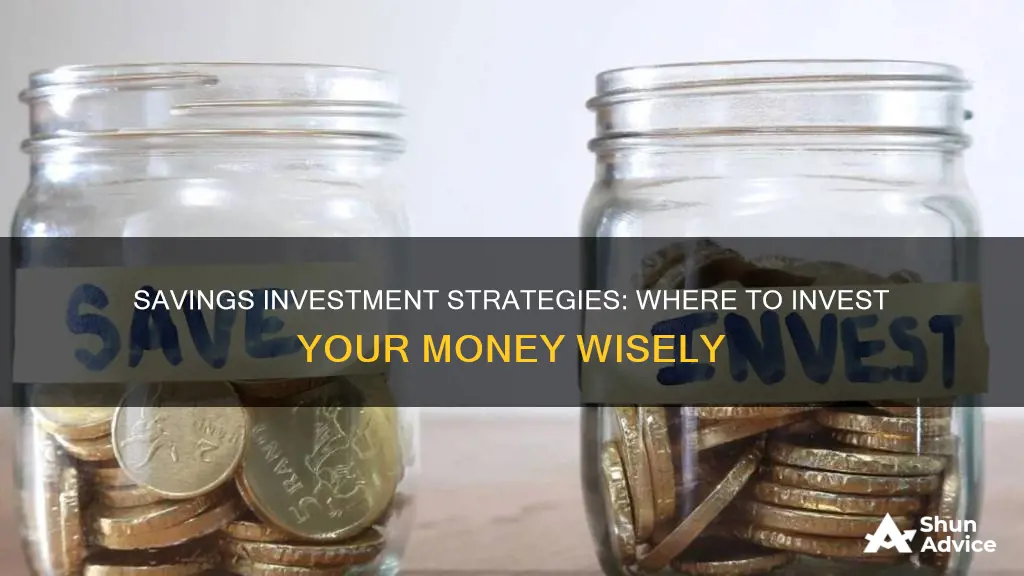
There are many options for investing your savings, from low-risk savings accounts to higher-risk stocks. The best option for you depends on your financial goals, risk tolerance, and investment style. Here are some of the most common investment options:
- High-yield savings accounts: These accounts offer a much higher annual percentage yield (APY) than traditional savings accounts, allowing you to maximize your returns without the risk of investing.
- Certificates of deposit (CDs): CDs are a type of savings account that offers a higher APY than traditional savings accounts. You deposit a lump sum of cash for an agreed-upon time frame, and you cannot access the funds without a penalty during this period.
- Money market accounts (MMAs): MMAs are another type of low-risk savings account that often comes with additional benefits, such as a debit card or check-writing capabilities.
- Mutual funds: Mutual funds are a group of investments that you buy a share of. A manager determines where to invest the money, which helps diversify your investments and avoid putting all your eggs in one basket.
- Exchange-traded funds (ETFs): ETFs are similar to mutual funds but are bought and sold throughout the day, and investors buy them for a fluctuating share price. ETFs are typically cheaper to purchase and manage than mutual funds.
- Individual stocks: Investing in individual stocks can be risky, but it can pay off in the long run if you do it right. When you buy stocks, you're essentially buying an ownership stake in a business.
- Real estate: Investing in real estate can be expensive, but it offers the potential for high returns. You can invest in rental properties, REITs (real estate investment trusts), or online platforms that allow you to invest in a diversified portfolio of real estate properties.
- Bonds: Bonds are a type of loan to a company or government that pays back a fixed rate of return. They are considered a safer investment than stocks but still carry some risk.
- Robo-advisors: Robo-advisors are automated investment platforms that use algorithms to invest your money based on your financial goals and risk tolerance. They are a hands-off approach to investing and typically charge lower fees than traditional advisors.
| Characteristics | Values |
|---|---|
| Risk level | Low, medium, high |
| Returns | 4% to 12% |
| Investment type | High-yield savings accounts, real estate, stocks, bonds, mutual funds, exchange-traded funds, certificates of deposit, money market accounts, dividend stock funds, value stock funds, small-cap stock funds, rental housing, S&P 500 index funds, Nasdaq-100 index funds |
| Investment style | Active, passive |
| Investment horizon | Short-term, long-term |
| Investment amount | $100, $1,000 |
What You'll Learn

High-yield savings accounts
When choosing a high-yield savings account, it's important to consider the APY, minimum balance requirements, fees, and digital features. Some accounts may also offer tools for setting savings goals, and it's worth checking if the account can be opened and managed entirely online.
Overall, high-yield savings accounts are a great option for those who want to boost their savings without taking on additional risk. With competitive rates, easy access, and minimal fees, these accounts can help you grow your savings faster and more efficiently.
Investing Life Savings: Strategies for Long-Term Financial Growth
You may want to see also

Long-term certificates of deposit
CDs are a good option if you want to save money for a large purchase in the future, such as a car or a down payment on a house. They offer guaranteed returns without much risk, and your money is protected up to $250,000 by the Federal Deposit Insurance Corporation (FDIC) for banks or the National Credit Union Administration (NCUA) for credit unions.
When choosing a long-term CD, there are a few things to consider:
- CD Term: Long-term CDs typically range from three months to five years. Longer-term CDs usually offer higher interest rates than shorter-term ones.
- CD Type: There are several types of CDs available, such as no-penalty CDs, which allow early withdrawals without a penalty, and bump-up CDs, which let you increase your interest rate during the term.
- CD Rate: Compare banks and credit unions to find the most competitive interest rates. Online banks often offer better rates than traditional brick-and-mortar banks.
- CD Deposit: The amount you deposit depends on your savings goals, but it's generally recommended to deposit more than the minimum requirement. You usually can't add more money to a CD after the initial deposit.
- Quontic Bank: Offers CD terms ranging from three months to five years, with competitive interest rates starting at 3.00% APY for a three-month CD and going up to 4.95% APY for a five-year CD. The minimum deposit required is $500.
- America First Credit Union: Provides a wide range of CD terms, from three months to 60 months, with highly competitive interest rates. They also offer specialty CDs, such as bump-rate CDs. The minimum deposit is $500.
- Barclays Bank: Offers CD terms ranging from six months to five years, with competitive interest rates starting at 3.00% APY for a six-month CD and going up to 4.65% APY for a five-year CD. There is no minimum deposit required.
- Capital One: Features CD terms of six months to five years, with no minimum deposit requirement. Their interest rates are competitive, making them a good choice for anyone looking for a fixed yield.
- Popular Direct: Provides CD terms of three months to five years, with interest rates starting at 3.40% APY for a three-month CD and going up to 4.50% APY for a five-year CD. However, they have a high minimum deposit requirement of $10,000.
When choosing a long-term CD, be sure to compare the interest rates, term lengths, and minimum deposit requirements to find the best option for your savings goals.
Saving vs. Investing: Ramsey's Key Differences Explained
You may want to see also

Long-term corporate bond funds
When considering investing in long-term corporate bond funds, it is important to keep in mind that they have a higher risk than government-backed bonds. This is because they are issued by corporations and, therefore, depend on the company's success.
Some examples of long-term corporate bond funds include:
- SPDR® Portfolio Long Term Corp Bd ETF
- IShares 10+ Year Invmt Grd Corp Bd ETF
- IShares Core 10+ Year USD Bond ETF
- Invesco Taxable Municipal Bond ETF
- Vanguard Long-Term Corporate Bd ETF
- Vanguard Long-Term Bond ETF
Saving and Investing: Building Wealth and Security
You may want to see also

Dividend stock funds
When investing in dividend stocks, it is important to diversify your portfolio to minimise risk. This can be achieved by investing in an index fund that provides exposure to a broad range of companies or adopting a "core & explore" approach, where the majority of your portfolio is in an index fund, and a smaller portion is allocated to individual stocks. Diversification ensures that your portfolio is insulated from the risk of any single company causing significant losses.
There are different types of dividend stocks to consider:
- High-dividend exchange-traded funds (ETFs): ETFs are a popular investment vehicle that trades on stock exchanges. High-dividend ETFs are attractive to income-oriented investors as they provide steady cash flow and the potential for long-term capital appreciation. Examples include the SPDR Blackstone High Income ETF and the Alerian MLP ETF, which focuses on master limited partnerships in the energy industry.
- Mutual funds: Mutual funds are investment companies that pool money from investors to purchase securities such as stocks or bonds. They are professionally managed and enable investors to diversify their portfolio by spreading their investments across many different securities. Mutual funds are suitable for those seeking a more hands-off approach to investing.
- Individual stocks: Investing in individual dividend-paying stocks allows you to choose specific companies you believe will perform well and increase their dividends over time. This approach requires more research and carries more risk than investing in funds. However, it can be rewarding if you are willing to put in the time and effort.
When considering dividend stock funds, it is important to evaluate your financial goals, risk tolerance, and the amount of money you have to invest. Dividend stocks are generally suitable for those with a long-term investment horizon, as they may experience volatility in the short term. Additionally, keep in mind the tax implications of dividend income, as taxes on dividends vary depending on your jurisdiction.
Loans: Saving or Investing? Understanding the Financial Impact
You may want to see also

Value stock funds
When it comes to value stock funds, there are a few different types to choose from. Mutual funds and exchange-traded funds (ETFs) are two popular options. Mutual funds are actively managed by fund managers who pick and choose where to invest your money. ETFs, on the other hand, track a specific market index, such as the S&P 500. ETFs are typically cheaper to buy and manage than mutual funds, but they may not offer the same level of diversification as mutual funds.
When choosing a value stock fund, it's important to consider the fees associated with the fund, as well as the fund's performance over time. It's also a good idea to diversify your investments across multiple value stock funds to further reduce your risk. Some popular value stock funds include:
- Vanguard Value ETF (VTV)
- IShares Russell 1000 Value ETF (IWD)
- Vanguard Small-Cap Value ETF (VBR)
- Vanguard Mid-Cap Value ETF (VOE)
- Fidelity High Dividend ETF (FDVV)
- SPDR Russell 1000 Yield Focus ETF (ONEY)
Investing in value stock funds can be a great way to grow your wealth over time, but it's important to remember that all investments come with some level of risk. Make sure to do your own research or consult a financial advisor before investing your money.
National Saving Scheme: Smart Investment Strategies
You may want to see also
Frequently asked questions
Before you start investing money, you need to determine your budget and risk tolerance. That is, are you willing to take on more risk for the potential of superior returns, or is your main priority to make sure you don't lose money? Then, you can decide on your investment style and choose whether to buy individual stocks or use passive investment vehicles like exchange-traded funds (ETFs) or mutual funds. Once you've decided all of that and done some investment research, you can open a brokerage account and get started.
There are many ways to invest money, including stocks, bonds, mutual funds, exchange-traded funds (ETFs), certificates of deposit (CDs), savings accounts, and more. The best option for you depends on your particular risk tolerance and financial goals.
Over time, the stock market has produced annualized returns of 9% to 10%, although performance can vary dramatically from year to year. On the other hand, fixed-income investments, like bonds, have historically generated 4% to 6% per year but with far less volatility.







